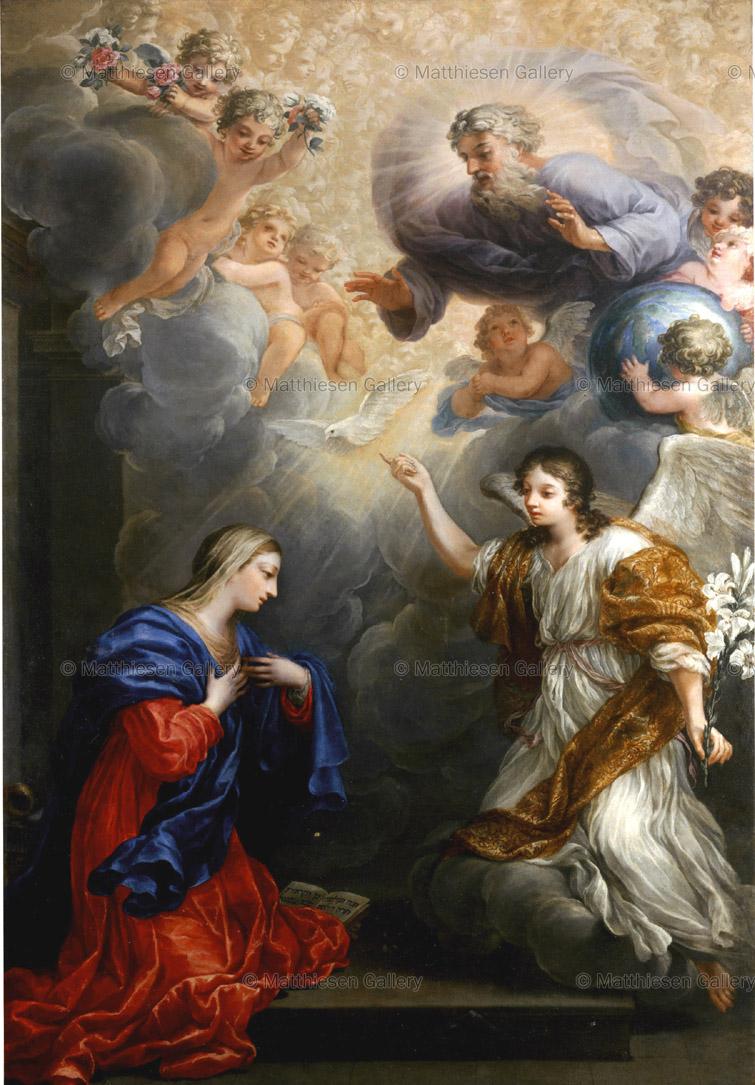The Annunciation(Johann Paul Schor)
JOHANN PAUL SCHOR
(Innsbruck 1615-1674 Rome)
The Annunciation
The Annunciation was traditionally attributed to Ludovico Mazzani by Professor Giancarlo Sestieri. Born to a noble family in Orvieto, Mazzanti had entered the workshop of Giovanni Battista Gaulli, il Baccicio when he was barely fourteen. There in Rome he worked alongside Gaullis other favoured pupil Giovanni Odazzi (1663-1731), encountered the work of Carlo Marrati, and collaborated with Nicolò Pomarancio in the church of Santa Maria Apollonaire. Most of his early period was spent in Rome, where his works include Frescoes in the vault of the Capella dellAssunta, S. Ignazio (1720); and the four large altarpieces in Sant Andrea al Quirinale, one of his most important commissions. During this early part of his career he also worked in Orvieto, where he designed the upper mosaics for the Cathedral façade (1713-1714). The painting had been considered to belong to his early Roman period.
Very recently Erich Schleier has suggested an earlier dating by another artist. Since then it has been realised that the painterly quality of this beautiful altarpiece must make it some forty years earlier circa 1660-70 also because of the strong impact of Pietro da Cortona who died in the middle of that decade. In addition Professor F. Petrucci noted the angel wears a shawl decorated with oak leaves, the emblem of the Chigi. It is now being suggested that this is a rare surviving altarpiece by Johann Paul Schor (1615-1674), known in Rome as Giovanni Paolo Tedesco (Tedesco literally means German in Italian), was an Austrian artist. He was the preeminent designer of decorative arts in Baroque Rome, providing drawings for state beds, fireworks, coaches, silver, textile sand even banquet setpieces executed in sugar. His numerous drawings have often been attributed in the past to Bernini.
Born in Innsbruck, he was a member of an extended Tyrolese artistic family, who received his training in the active studio of his father, Hans Schor. In 1640 he established himself in Rome. There, in 1654, he became a member of the Academia di San Luca, the artists academy.
Influenced by Bernini and Pietro da Cortona, the originality of his designs and his versatility gained him a prominent position among artists, patrons and craftsmen in Rome: he united in his work the highly expressive artistic legacies of Cortona and Bernini with a calligraphic freedom, apparently stemming from Calllot and Stefano Della Bella, which at times seems to foreshadow the rococo (Hibbard, 1985:205). Under Cortona he helped decorate the Palazzo del Quirinale for Pope Alexander V11 Chigi. In 1659, the Pope also commissioned Schor to execute Berninis designs for rebuilding of the Chigi family chapel (Capella della Madonna del Voto in the Duomo di Siena. In Rome, Schor assisted Bernini, in the gilt-bronze encasing of the Chair of Saint Peter (Lanciani 1892), and other projects in the late 1650s and 1660s (Hibbard 1958:205 note 10). Perhaps his most prominent undertaking was the baldacchino in Santo Spirito in Sassia.
Schor also helped decorate rooms of the Vatican and in Palazzo Borghese, where he collaborated with Carlo Rainaldi on the fountain for the nympheum in the courtyard, depicting Venus at the Bath. He supplied illusionistic quadratura suggesting sculptural enframements for ceilings at Palazzo Colonna, (1665-1668), where the painted subjects where provided by Giovanni Coli and Filippo Gheradi (Kellermann, 1924, 155-156).
Limitations as a graphic artist might be suggested by the frontispiece that he provided for Athanasius Kirchers Musurgia Universalis, 1650, but there, doubtless the composition was overloaded by the allegorical program provided by Kircher himself. When working on his own, his surviving drawings show more proficiency.
In his workshop during the 1670s he employed a young Austrian draughtsman named Johann Bernhard Fischer, who returned to Vienna and a career in which he was ennobled as Fischer von Erlach, the pre-eminent Viennese practitioner of High Baroque architecture.
Johann Paul Schor died in Rome in 1674.

